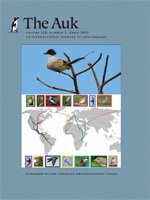Migratory connectivity for small migratory passerines has been quantified primarily with stable hydrogen isotopes in feathers (δ2HF) because, until recently, we lacked the technology to track small organisms over long distances. Direct tracking of small passerines throughout the annual cycle is now possible with archival light-level geolocators. Our objective was to evaluate whether δ2HF and geolocators produce similar breeding-origin assignments for the same individual birds sampled during the non-breeding season. We estimated breeding origin with geolocators and δ2HF and validated those estimates using a population of Ovenbirds (Seiurus aurocapilla) from a known breeding location at Hubbard Brook Experimental Forest, New Hampshire. We also deployed geolocators on Ovenbirds in Jamaica and Florida during March 2010–2011. We performed stable hydrogen isotope analysis on feathers of birds whose geolocators we recovered (Jamaica: n = 9; Florida: n = 3). Probabilistic assignments of δ2HF that accounted for regional variation in feather-isotope discrimination predicted breeding origins that agreed with kernel density estimates of origin derived from geolocators. By contrast, assignments of δ2HF using the common assumption of a consistent feather-isotope discrimination across space predicted breeding origins that overlapped minimally with those from geolocators. Finally, Bayesian analyses that incorporated prior information of Ovenbird abundance across the breeding range yielded more accurate assignments for both site-independent and site-specific discrimination factors. Our findings suggest that creating more detailed feather isoscapes by increasing the number of validation locations and sampling underrepresented portions of species distributions could increase the accuracy of geographic assignments using δ2HF.
How to translate text using browser tools
1 April 2013
Do Archival Light-Level Geolocators and Stable Hydrogen Isotopes Provide Comparable Estimates of Breeding-Ground Origin?
Michael T. Hallworth,
Colin E. Studds,
T. Scott Sillett,
Peter P. Marra

The Auk
Vol. 130 • No. 2
April 2013
Vol. 130 • No. 2
April 2013
Bayesian
deuterium
discrimination
migratory bird
Ovenbird
Seiurus aurocapilla
solar geolocator




